Think of your store's inventory as a living, breathing part of your business. Now, imagine trying to keep track of it with a clipboard and a pen. It's a recipe for mistakes, stockouts, and frustrated customers. That’s where POS inventory tracking comes in—it’s the central nervous system connecting your sales floor to your stockroom.
What Is POS Inventory Tracking And Why It Matters
At its heart, POS inventory tracking is a simple concept: when a customer buys a product, your point-of-sale (POS) system automatically deducts it from your inventory count. No more manual updates. No more guessing games. Just a clean, real-time picture of what’s on your shelves, what's selling, and what isn't.
Think of it this way: without it, you're flying blind. You might run out of a top-selling item on a busy Saturday, leading to lost sales and unhappy shoppers. Or worse, you might have cash tied up in products that are just gathering dust in the back. This automated system gives you the vision you need to make smart, profitable decisions on the fly.
The Power of Automation
Switching from manual counts to an automated POS system is less of an upgrade and more of a total transformation. It shifts you from a reactive position—scrambling to fix problems—to a proactive one where you can see issues coming and steer clear.
This is what that shift looks like in practice:
- Fewer Mistakes: Manual entry is prone to human error. A simple typo can throw off your entire count. Automation eliminates that risk.
- Time Back in Your Day: Your team can stop spending hours counting boxes and instead focus on what they do best: helping customers.
- Pinpoint Accuracy: The data is live. You always know exactly what you have in stock, down to the last unit.
- Smarter Ordering: By tracking sales trends, you know precisely what to reorder and when, preventing both stockouts and overstocking.
The move toward this kind of technology isn't just a niche trend; it's a massive shift in how businesses operate. The data speaks for itself.
The global POS market is on track to explode, projected to grow from USD 38.56 billion in 2025 to an incredible USD 110.22 billion by 2032. With over 72% of retailers already on cloud-based systems and the mobile POS market expected to hit $55 billion, it's clear that modern inventory management is the new standard. This is just one component of the broader world of inventory management software.
Exploring Core POS Inventory System Features
Modern POS systems have evolved far beyond the digital cash registers of the past. Today, they're the command center for your entire operation, and each feature is built to solve a specific, often costly, problem that business owners know all too well. When you understand how these tools work together, you can turn inventory management from a reactive chore into a real strategic advantage.
Let's break down the most important features you'll find in a quality POS inventory system.
Essential POS Inventory Tracking Features
A great POS system is a suite of interconnected tools. Below is a look at the core features and how they directly impact your day-to-day operations and bottom line.
| Feature | Description | Key Business Benefit |
|---|---|---|
| Real-Time Stock Updating | Instantly adjusts inventory counts across all channels the moment a sale is made, a return is processed, or new stock arrives. | Prevents overselling and stockouts, improves customer satisfaction, and ensures data is always accurate for decision-making. You sell with confidence, knowing what you see on the screen is what you actually have. |
| Automated Reordering | Allows you to set minimum stock thresholds (par levels) for products. When inventory drops below this level, the system automatically alerts you or creates a draft purchase order for your supplier. | Eliminates the manual work of checking stock levels and saves you from running out of popular items. It’s like having a purchasing assistant who never sleeps, ensuring your best-sellers are always available. |
| Multi-Location Management | Consolidates inventory data from multiple physical stores, warehouses, and online channels into a single, unified dashboard. You can view stock levels, transfer items between locations, and manage everything from one place. | Gives you a complete, bird's-eye view of your entire business. This makes it easy to balance stock across locations, prevent lost sales due to out-of-stocks at one store, and create a seamless experience for customers no matter where they shop. |
| Sales Analytics & Reporting | Captures and organizes vast amounts of sales data, transforming it into easy-to-understand reports. It can identify best-sellers, slow-moving items, peak sales times, and customer purchasing habits. | Moves you from guessing to knowing. These insights empower you to make smarter buying decisions, optimize staffing, run targeted promotions that actually work, and ultimately increase profitability by stocking what your customers truly want. |
These features aren't just bells and whistles; they are fundamental tools that directly address the biggest inventory headaches.
Putting The Features To Work
The foundational feature is real-time stock updating. Think of a bookstore: every time someone buys a novel, the system’s count for that title instantly drops by one. This simple, automated action prevents the all-too-common nightmare of selling a book online that you no longer have on the shelf. It’s a small thing that protects both your revenue and your reputation.
This live data is critical. Shockingly, the accuracy of inventory data remains a huge challenge in retail, with many systems operating at only 70% accuracy on average. That 30% gap leads to real financial losses from inefficient operations and missed sales.
From there, automated reordering acts as your personal stock manager. You can set a minimum quantity for any product—this is called a "par level." When your stock drops below that line, the system can ping you with an alert or even draft a purchase order to send to your supplier.
For example, a coffee shop might set a par level of 10 bags for its house espresso beans. The moment the 11th bag is sold, the POS flags the item for reorder. It’s a proactive approach that ensures you never run out of what your customers love most.
For businesses with multiple storefronts or an online shop, multi-location management is a game-changer. It provides a single dashboard to see your entire inventory ecosystem. You can check stock levels at each location, transfer products between stores to meet local demand, and keep everything consistent.
Imagine a boutique with two locations. A customer at Store A wants a dress that’s only available at Store B. The sales associate can instantly see that, confirm its availability, and arrange a transfer or point the customer in the right direction. This saves the sale and creates a smooth experience.
A robust POS system unifies every sales channel—brick-and-mortar, eCommerce, pop-up shops—into a single, manageable inventory pool. This prevents overselling and provides a true holistic view of your business's health.
Finally, we get to what is arguably the most powerful feature: sales analytics. Your POS system is a data-collecting machine, constantly logging what sells, when it sells, and how fast. This information is pure gold for making smarter business decisions.
These tools can generate reports that reveal:
- Best-Sellers and Slow-Movers: See which products are making you money and which are just tying up cash on a shelf.
- Sales Trends: Spot patterns related to seasons, days of the week, or even times of day to fine-tune your staffing and promotions.
- Customer Purchase History: Understand what your loyal customers buy, which opens the door for targeted marketing and personalized offers.
Let's go back to our local bookstore. The manager uses sales analytics to see that a fantasy series isn't moving. Armed with that data, they can run a "buy one, get one" promo to clear space. At the same time, the system might show that a local author's new book is flying off the shelves, prompting an immediate reorder to capitalize on the buzz.
By turning raw sales numbers into actionable intelligence, these features give you the power to optimize every corner of your business. For more insights on picking the right platform, check out our guide on the best retail POS software with built-in inventory management.
The Business Impact of Automated Inventory Tracking
It’s one thing to talk about the features of a POS inventory tracking system, but it’s another to see how it actually puts money back into your pocket. Moving away from manual spreadsheets and clipboards isn't just a simple tech upgrade. It's a total shift in how you operate, leading to real, measurable results that show up on your bottom line.
Think about a small shop owner stuck in a nightmare inventory cycle. Their backroom is pure guesswork. Bestsellers vanish off the shelves unexpectedly, leaving customers disappointed and sales on the table. At the same time, a chunk of their cash is tied up in slow-moving items that are just gathering dust. The owner loses hours every week to manual counts, a mind-numbing task riddled with errors that throw off their financial reports.
Now, imagine they switch to a POS with automated tracking. The picture changes completely. Every single sale updates stock levels instantly. This gives them a perfect, real-time snapshot of everything they have. That one change takes care of the two biggest profit killers in retail: stockouts and overstock.
Turning Data Into Profitability
The most immediate impact you’ll see is on your profits. By keeping you from over-ordering, automated tracking frees up cash that would otherwise be sitting idle on your shelves. It also means you won't have to run as many deep-discount sales just to clear out old stock, which is great for protecting your margins.
On the flip side, by making sure you never run out of your most popular items, you capture every possible sale. You’ll never have to say, "Sorry, we're fresh out of that one." When customers know they can count on you to have what they need, they keep coming back.
This precision goes way beyond the sales floor. A huge part of your financial picture involves understanding your Cost of Goods Sold (COGS). An automated system gives you the exact sales and stock numbers you need to calculate COGS correctly, giving you a crystal-clear view of your business's health.
Accurate, real-time data is the foundation of smart business decisions. It moves you from reacting to problems to proactively shaping outcomes, giving you the control needed for sustainable growth.
Enhancing Operational Efficiency
On top of the financial wins, automated POS inventory tracking makes your day-to-day operations so much smoother. All those hours you and your team used to waste on manual counts can now be spent on things that actually grow the business—like talking to customers, planning a marketing campaign, or brainstorming new ideas.
This boost in efficiency creates a better experience for your customers, too. Real-time inventory is a huge competitive edge. In fact, research shows retailers who use these systems see an impressive 20% increase in customer satisfaction. Why? Because they can give customers accurate information on what's available right now. With 82% of shoppers recently reporting they’ve run into out-of-stock items, just being able to deliver on your promise is a massive win for loyalty.
The benefits just keep stacking up over time, creating a stronger, more agile business:
- Reduced Human Error: Automation gets rid of the costly typos and miscounts that are unavoidable with manual data entry.
- Faster Fulfillment: When you know exactly what you have and where it is, your team can grab products and get orders out the door in record time.
- Improved Decision-Making: Armed with reliable data, you can make smarter, faster calls on everything from purchasing and promotions to pricing.
Ultimately, automated POS inventory tracking creates a powerful positive cycle. Better efficiency leads to higher profits, which you can reinvest. Better data leads to smarter decisions, which drives even more growth. It turns inventory from a constant headache into a strategic tool that powers your success.
Getting Your POS Inventory System Up and Running
Switching to a modern POS inventory tracking system can seem like a massive project, but you don't have to tackle it all at once. If you break the process down into a few clear, manageable steps, you can make the transition a lot smoother and set yourself up for success right from the start.
Think of this as your roadmap. Let's walk through it.
The very first step has nothing to do with software. It’s all about taking a hard, honest look at what you’re doing right now.
Start With an Audit of Your Current Process
Before you can find the right solution, you need to know exactly what’s broken. Map out how you handle inventory today. Are you scribbling on a clipboard? Juggling messy spreadsheets? Or just trying to keep it all in your head?
Get specific about the headaches this causes. You're probably dealing with issues like:
- Running out of best-sellers, forcing you to tell customers, "Sorry, we're out."
- Tying up cash in overstocked items that just sit on the shelf gathering dust.
- Wasting hours on manual counts that pull your team away from helping customers.
- Relying on bad data because of simple typos and human error.
Listing these problems gives you a clear checklist. Any new system you consider must solve these specific issues. This audit is the foundation for every other decision you'll make.
Choose the Right Software for Your Business
With your needs clearly defined, it's time to start looking at different POS systems. You’re not just shopping for a tool to fix today's problems; you're looking for a partner that can grow with you. Ask yourself: will this system still work if I open a second location? What if I want to start selling online next year?
Pay close attention to features built for your specific industry. A coffee shop needs to track milk and espresso beans by the ounce, while a clothing boutique needs to manage sizes and colors for every single t-shirt. Your choice should feel like it was made just for you.
Your POS system should be more than just a tool; it should be a partner in your growth. Choose software that adapts to your needs, not the other way around. This ensures your investment pays dividends for years to come.
Get Your Product Data Moved Over
Once you've picked your software, the next crucial step is getting all your product information into the new system. This is where accuracy is everything. Most modern POS platforms let you import your product list with a simple CSV file, which you can easily create from your current spreadsheets.
But before you hit "upload," take some time to clean up that data.
- Standardize Product Names: Make sure "Men's Lg Blue Tee" is always written the same way.
- Check SKUs and Barcodes: Every unique item needs a correct identifier. No duplicates!
- Confirm Supplier Info: Are the contact details and costs from your vendors up to date?
- Input Accurate Costs: This is critical. Getting the cost right is the only way your profit margin reports will be accurate.
A clean data import will save you from a world of frustration later on and ensure your reports are trustworthy from day one. As you set things up, it’s also worth looking into how your POS can work with other tools. For example, integrating specialized inventory software can add even more powerful features to your setup.
Train Your Team for Success
A powerful system is useless if your team doesn't know how to use it. Don't treat training as an afterthought—it's absolutely essential. Get your staff hands-on with the new system, focusing on the tasks they'll perform every single day.
Make sure your training covers the basics:
- Ringing up sales, processing returns, and making exchanges.
- Checking in new stock deliveries and updating counts.
- Looking up stock levels for a customer who asks.
- Understanding how their actions directly affect inventory numbers.
When your team gets the "why" behind the process, they become much more invested in keeping the data clean and accurate.
Set Up Your Reports and Alerts
Finally, it's time to let the system do the heavy lifting for you. Dive into the reporting features and build a dashboard that gives you a quick snapshot of your most important metrics—things like sales trends, inventory turnover, and which items are running low.
The real game-changer here is setting up automated low-stock alerts. By setting "par levels"—the minimum amount of an item you always want to have on hand—the system will automatically flag it for reorder. This simple step turns your POS into a proactive watchdog, preventing stockouts before they ever happen.
Best Practices for Smarter Stock Management
Getting a POS inventory tracking system in place is a game-changer, but the real wins come from how you use it. Think of your POS as more than just a digital ledger; it's a treasure trove of data that tells the story of your business. By adopting a few smart habits, you can turn that data into your secret weapon for boosting profits and driving growth.
It’s all about shifting from a reactive mindset—just watching stock levels—to a proactive one. You'll start making smarter decisions that protect your cash flow, keep your shelves stocked with what customers want, and stop problems before they start.
Conduct Regular Cycle Counts
Forget the once-a-year, all-hands-on-deck physical inventory count that forces you to shut down for a day. That's the old way. The smarter approach is cycle counting.
This just means counting small, specific sections of your inventory on a rotating schedule—maybe daily or weekly. Today you might count all the blue t-shirts. Tomorrow, the denim jackets. It's a continuous spot-check that’s way less disruptive and keeps your data accurate all year long. This helps you catch issues like theft, damage, or receiving mistakes early before they become massive headaches.
A POS system tells you what inventory you should have. Cycle counts confirm what you actually have. The smaller the gap between those two numbers, the healthier your business.
Use Sales Reports for Smart Forecasting
Your POS is constantly tracking what sells, when, and how fast. This historical data is basically a crystal ball for predicting future demand. You just have to look.
Dig into your sales reports to spot patterns. For instance, a boutique owner might look at last winter's data and see that wool scarves sold steadily, but insulated gloves only flew off the shelves during the two coldest weeks. Armed with that knowledge, they can order scarves consistently but place a larger, perfectly timed order for gloves right before the next cold snap. This is how you maximize sales without getting stuck with dead stock. Learning a few inventory forecasting techniques is how you turn old data into new profits.
Apply Strategic Inventory Methods
Not all products are created equal, so they shouldn't be managed the same way. A good POS makes it easy to apply proven inventory methods where they make sense.
- FIFO (First-In, First-Out): This is non-negotiable for businesses with perishable goods. It’s a simple rule: sell the oldest stock first. For a coffee shop selling pastries or a grocer with dairy products, FIFO is the key to minimizing spoilage and waste.
- ABC Analysis: This method helps you focus your attention where it matters most. You categorize items based on their value to your business. "A" items are your high-value bestsellers that need constant monitoring. "C" items are your low-value, slow-movers that don't need as much oversight. Your POS data makes this analysis a breeze.
Using the right strategy for the right product helps you optimize how your stock moves and protects your profit margins from preventable losses.
Leverage Variance Reports to Find Issues
A variance report is one of the most powerful tools in your arsenal. It directly compares the stock levels your POS system thinks you have against your actual, physical count. Any difference—or variance—is a red flag.
If a report shows your POS has 15 units of a product recorded, but you can only find 10 on the shelf, that five-unit gap is a problem you need to investigate. Is it theft? An unscanned return? A supplier who shorted you on the last delivery? These reports give you the specific data you need to dig in, find the root cause, and plug financial leaks before they sink your business.
It's Time to Get Smart About Your Inventory
If you're still relying on manual counts and messy spreadsheets, it's time for a change. Ditching those old methods isn't just about saving a little time; it's a strategic shift that fundamentally changes how you run your business. Moving to a modern POS inventory tracking system is your ticket to building a more profitable, stable, and customer-focused operation.
This isn't just about upgrading your tech. It’s about trading guesswork for genuine insight. When real-time data drives every decision you make, your inventory stops being a source of stress and becomes one of your most powerful assets. The benefits aren't abstract concepts—they're real, measurable improvements you'll see every day.
A Quick Look at the Wins
Putting a solid POS inventory system in place pays off in big ways across your entire business:
- Know Exactly What You Have: Get a live, up-to-the-minute view of your stock. This means no more embarrassing stockouts or accidentally selling items you don't have.
- Work Smarter, Not Harder: Imagine all the hours your team will get back by automating stock counts. You'll cut down on human error and make your day-to-day operations run so much smoother.
- Keep Your Customers Happy: Nothing builds loyalty like having the products people want, when they want them. A reliable inventory means a great shopping experience.
- Make Decisions with Confidence: Use crystal-clear sales data to see what’s hot and what’s not. This helps you buy smarter, forecast demand, and boost your bottom line.
Switching to an automated system is one of the best investments you can make for your business. It gives you the control and clarity you need to compete and grow.
In the end, smarter inventory management starts with a simple choice. Take a hard look at how you're doing things now and pinpoint what's causing you headaches. By taking control of your stock with the right tools, you're setting yourself up for long-term success. Your business deserves that.
Got Questions? We've Got Answers
Stepping into the world of POS inventory tracking can feel like a big move, and it's natural to have a few questions. We've gathered the most common ones we hear from business owners and laid out some clear, no-nonsense answers.
How Exactly Does a POS System Track Inventory Automatically?
It's actually a pretty elegant process. Think of it this way: every single product you sell gets its own unique digital fingerprint, usually in the form of a barcode or SKU (Stock Keeping Unit).
When a customer brings an item to the checkout and you scan it, the POS system instantly recognizes that "fingerprint." In that split second, it registers the sale and automatically subtracts that one item from your total inventory count. It's a live, real-time update with every transaction, giving you a constantly accurate picture of what's on your shelves.
Is This Kind of System a Good Fit For a Cafe or Restaurant?
A good fit? It's practically essential. For any food and beverage business, a smart POS goes way beyond just tracking finished menu items. It digs deeper, managing the individual ingredients that go into them.
Imagine you sell a latte. The system doesn't just see "one latte sold." It sees the specific amount of espresso beans, milk, and syrup that went into making it, and deducts those raw ingredients from your stock. This level of detail is a game-changer for controlling food costs, slashing waste, and making sure you never run out of oat milk during the morning rush.
I'm Not a Tech Expert. Is Setting This Up Going to Be a Nightmare?
That’s a totally valid concern, but you can breathe easy. Modern, cloud-based POS systems are built for busy entrepreneurs, not IT wizards. They're designed from the ground up to be intuitive.
Most platforms will guide you through the setup, often with simple tools to import all your product information from a spreadsheet. Plus, good companies back their software with real human support to help you get everything running smoothly. The goal isn't to add another complicated task to your plate—it's to make your life easier.
The core difference is that a barcode scanner is the tool that captures data, while the POS system is the intelligent software that processes that data to manage your entire operation.
Here’s a simple analogy: the scanner is the eyes, but the POS system is the brain. The scanner just reads what's in front of it. The POS brain is what understands that information, updates your inventory, logs the sale, and pulls it all together into reports that help you make smarter decisions. One is a piece of hardware; the other is the complete solution.
Ready to stop guessing and start knowing? Biyo POS gives you a powerful, all-in-one inventory solution to get a real-time grip on your business, boost profits, and keep customers coming back. It’s time to take control of your stock. Learn more about Biyo POS and see how it works.








